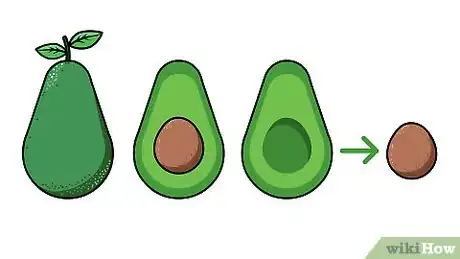This article was co-authored by Andrew Carberry, MPH. Andrew Carberry is a Food Systems Expert and the Senior Program Associate at the Wallace Centere at Winrock International in Little Rock, Arkansas. He has worked in food systems since 2008 and has experience working on farm-to-school projects, food safety programs, and working with local and state coalitions in Arkansas. He is a graduate of the College of William and Mary and holds a Masters degree in public health and nutrition from the University of Tennessee.
wikiHow marks an article as reader-approved once it receives enough positive feedback. This article received 79 testimonials and 91% of readers who voted found it helpful, earning it our reader-approved status.
This article has been viewed 3,162,126 times.
The next time you eat an avocado or use one in a recipe, save the stone or pit. Planting your own avocado tree is fun and easy. It is a perfect task for all ages — for the garden, for indoors, and also makes a great project for class or at home! This method will yield a tree that flowers, but not one that bears fruit. If you want to grow an avocado tree for fruit, it is best to purchase a grafted tree from a nursery.
Steps
Water Sprouting
Preparing the Seed
-
1Remove the pit. Cut into the avocado carefully, so as not to injure the pit, which is in the fruit's center. You can do this by scoring the skin/fruit about ½ an inch (1.3 cm) deep all the way around the outside, and then twisting the two halves in opposite directions to open it. Carefully remove the pit and set it aside.
- So that you don’t waste the fruit, use the avocado meat to create the tasty dip/topping known as guacamole.
-
2Clean the pit. Wash the avocado pit gently to remove all the flesh. Use warm water and your hands, and avoid using soap. Be careful not to remove the seed cover which is light brown, as this may destroy the pit and make it less likely to grow.Advertisement
-
3Insert toothpicks into the pit. Holding the pit "narrow" (pointed) side up, stick four toothpicks into the middle section at even intervals, just enough to give a firm hold. This will allow you to balance the pit on the inside of a cup, without completely inserting it into the cup.
- The pit should sit in about 1 inch of water, so keep this in mind when inserting your toothpicks.
-
4Fill a cup/jar with water. Add some water to a small, slender container (preferably glass) until it reaches the top rim. Your container's opening should be wide enough to accommodate the full width of the avocado pit easily; however, make sure that it is not too wide, otherwise the toothpicks will not be able to reach and the pit will fall in.
-
5Set your avocado pit (with inserted toothpicks) on the top rim of the container. The toothpicks should sit on the rim of the container, leaving 1 inch of the pit only submerged in the water. Make sure the pointed end is up and the rounded end is in the water, otherwise your avocado will not grow.
-
6Wait for the pit to sprout. Set the avocado-topped container in a temperate, undisturbed place — near a window or any other well-lit area to begin rooting and the growth process.
-
7Change the water every one to two days. Do this to ensure that contaminants (i.e. mold, bacteria, fermentation, etc.) do not hinder the avocado's sprouting process. Ensure the base of the avocado always remains moist and submerged in water.
-
8Wait patiently for the pit to sprout roots. Over the next two to three weeks, the avocado's brown outer layer will begin to dry out and wrinkle, eventually sloughing off. Soon after, the pit should begin to split open at the top and bottom. After three to four weeks, a taproot should begin to emerge at the base of the pit.[1]
-
9Continue to water the plant accordingly. Take care not to disturb or injure the taproot. Continue to allow the avocado pit time to establish its roots. Soon, the avocado will sprout at the top, releasing an unfolding leaf-bud that will open and begin to grow a shoot bearing leaves.
Planting the Avocado Tree
-
1Select a location. Avocado trees are very particular in terms of their ideal climate and growing conditions. Most of the time, avocado trees should be planted in a pot, and moved around to meet the changing weather. Avocado trees prefer a temperature of 60 – 85°F (15.6 – 29.4°C), and established trees can handle temps as low as 28°F (-2.2°C).
-
2Prepare the soil. Avocado trees can grow in soil at almost any pH level, but it must be low in saline and have plenty of drainage. The soil does not need to be heavily fertilized until after the tree is about 1 year old. At that point, you should conduct a soil test to find out what nutrients are available/lacking in your soil. You can then get fertility recommendations based on the nutrients found in your soil.[2]
- You may want to use a 10-10-10 fertilizer twice a year to help the tree out. In general, you can use regular potting soil and add some rocks to the bottom of the pot to aid in draining excess water.[3]
-
3Prepare your plot. Use a 20 – 25 cm (7.8 – 9.8 inches) terracotta pot filled with enriched soil to 2 cm (.8 inches) below the top. A 50/50 blend of topsoil and coir (coconut fibre) usually works best, but make sure you check the soil where you're planting to ensure this is the right blend. Smooth and slightly pack the soil, adding more soil as needed. Once the soil is prepared, dig a narrow hole deep enough to accommodate your avocado's roots and pit.
-
4Get the seed ready. When the tree reaches 6-7 inches in height, prune it back to 3 inches. When leaves have re-grown, you are ready to plant. Remove the sprouted pit from the water container, and gently remove each of the toothpicks.
-
5Plant the avocado seed. Carefully bury the avocado pit in the soil such the top-half of pit shows above the surface of the soil. This ensures the base of the seedling trunk doesn't rot under the soil. Pack the soil lightly around the pit.
-
6Keep the tree hydrated. Water your plant daily or enough to keep the soil moist. Avoid over-watering to the point the soil becomes muddy. If the leaves turn brown at the tips, the tree needs more water, while if the leaves turn yellow, the tree is getting too much water and needs to be permitted to dry out for a day or two.
-
7Maintain your avocado tree. Continue to tend to your avocado plant regularly, and in a few years you will have an attractive and low-maintenance tree. Your family and friends will be impressed to know that you cultivated and grew your own tree from an avocado pit salvaged from your guacamole recipe.
Ground Growing
Some growers find that placing the seed in water to sprout it risks producing a long, leggy tree that fails to fruit. In this case, it is better to place the seed in the ground without soaking first.
-
1Obtain a good quality avocado fruit. Cut the fruit flesh away from the seed. It is easiest to cut it the long way around.
-
2Twist the seed to remove it. Whack it with a knife, then twist, and the seed will come out.
-
3Find the pointed end of the seed. this is the top of the seed.
-
4Choose a planting locale. See the above method for plant positioning suggestions. Clear the sod or whatever else is there, in readiness for planting.
- If possible, plant two trees, as these plants like company.
-
5Place the flat end down in the soil. Use your hands to mound up the loose soil around the seed. Do not stomp the dirt down with your foot as you may damage the seed this way.
-
6Follow the growing suggestions above. Fertilize after you see the plant above the ground. Do not do so sooner or the root system will fail to form properly. In about three to four years, expect fruit.
-
7Harvest fruit when the avocados look big and fat. They will not ripen on the tree. Remove and place inside a brown bag to ripen. They're ready to eat when soft.
Expert Q&A
Did you know you can get expert answers for this article?
Unlock expert answers by supporting wikiHow
-
QuestionWhen you say "plant two trees together they like company," does that mean two seeds together?
 Andrew Carberry, MPHAndrew Carberry is a Food Systems Expert and the Senior Program Associate at the Wallace Centere at Winrock International in Little Rock, Arkansas. He has worked in food systems since 2008 and has experience working on farm-to-school projects, food safety programs, and working with local and state coalitions in Arkansas. He is a graduate of the College of William and Mary and holds a Masters degree in public health and nutrition from the University of Tennessee.
Andrew Carberry, MPHAndrew Carberry is a Food Systems Expert and the Senior Program Associate at the Wallace Centere at Winrock International in Little Rock, Arkansas. He has worked in food systems since 2008 and has experience working on farm-to-school projects, food safety programs, and working with local and state coalitions in Arkansas. He is a graduate of the College of William and Mary and holds a Masters degree in public health and nutrition from the University of Tennessee.
Food Systems Expert
-
QuestionMy tree sprouted and is about 2 feet tall. Should I cut it back and cut the leaves off?
 Andrew Carberry, MPHAndrew Carberry is a Food Systems Expert and the Senior Program Associate at the Wallace Centere at Winrock International in Little Rock, Arkansas. He has worked in food systems since 2008 and has experience working on farm-to-school projects, food safety programs, and working with local and state coalitions in Arkansas. He is a graduate of the College of William and Mary and holds a Masters degree in public health and nutrition from the University of Tennessee.
Andrew Carberry, MPHAndrew Carberry is a Food Systems Expert and the Senior Program Associate at the Wallace Centere at Winrock International in Little Rock, Arkansas. He has worked in food systems since 2008 and has experience working on farm-to-school projects, food safety programs, and working with local and state coalitions in Arkansas. He is a graduate of the College of William and Mary and holds a Masters degree in public health and nutrition from the University of Tennessee.
Food Systems Expert
-
QuestionHow tall will the avocado tree get?
 DvorCommunity AnswerIt depends on the variety, but it can be anywhere from 4.5 meters (about 15 feet) to 12 meters (about 40 feet). There are also dwarf avocado trees that generally range from 1-1.5 meters (4-5 feet) tall.
DvorCommunity AnswerIt depends on the variety, but it can be anywhere from 4.5 meters (about 15 feet) to 12 meters (about 40 feet). There are also dwarf avocado trees that generally range from 1-1.5 meters (4-5 feet) tall.
Warnings
- An avocado tree grown from seed becomes very tall, unlike a grafted tree. Avocado branches are fragile and do not support any weight on them, so don't hang anything like a hammock from the tree branches as they will break off.⧼thumbs_response⧽
- Low lighting and/or improper watering can also create weak stems and branches, which ultimately will cause the plant to collapse under its own weight.⧼thumbs_response⧽
- Letting the pit's bottom tip dry out will most likely prevent the avocado from sprouting properly, if at all.⧼thumbs_response⧽
- It can be difficult to get an avocado tree grown from a pit derived from an avocado purchased at a store to produce fruit. Though store Avocados are not genetically altered, it takes specific conditions to produce fruit. Do not expect any fruit from it.⧼thumbs_response⧽
- Over-pruning (too much or too often) can stunt or stop leaf growth. After the first pruning, cut off only the very end leaf-buds on the stem and/or branches. For tree limbs and main stem trunk, pruning promotes both fuller branches and thicker, stronger leaves.⧼thumbs_response⧽
- Keep your plant away from cold breezes, breezy doorways, and cold windowpanes. If your tree is potted, keep it indoors until the temperature rises. For young, ground-planted avocado trees and most potted avocado trees, cover the plants leaves completely with a blanket or heavy plastic during cold weather, at least until warmer weather prevails. Well-established avocado trees can often survive mild frosts and temperatures near freezing. The best bet: Always cover your tree when in doubt.⧼thumbs_response⧽
- Not changing or adding water sufficiently to the sprouting avocado pit can allow contaminants to form in the water and/or on the roots. Molds, root rot, fungi, and fermenting water can quickly poison the entire plant. Keep the water fresh and at the proper level.⧼thumbs_response⧽
- Until the tree is well-established in a pot, do not plant it directly in the ground. A strong plant root system with well-loosened ground soil make for a good outdoor planting situation.⧼thumbs_response⧽
- Thin or spindly branches and stems make for a weak plant support foundation. Failure to prune often enough can create long, winding, weak branches and stems. Pruning allows the tree stem to thicken and grow more rigid.⧼thumbs_response⧽
Things You'll Need
- A whole, ripe avocado
- A tumbler or other shallow glass or plastic cup
- A sunny window to place your seed while it starts to grow.
- Four toothpicks
- Water
- A pot
- Rocks for drainage
- Dirt
References
About This Article
To plant an avocado tree, start by filling a pot with an even blend of topsoil and coconut fiber. Then, take the seed out of a fresh avocado and plant it in the pot so the thin end is sticking up above the soil. After you plant the avocado seed, water it thoroughly so the soil is moist. Avoid fertilizing the avocado seed until it sprouts or you could hurt the roots. While you wait for your avocado tree to sprout, water it every day or whenever the soil looks dry so it gets enough moisture. If you want to learn how to sprout an avocado in water from our Food Systems Expert co-author, keep reading!

























































